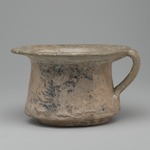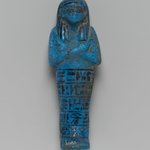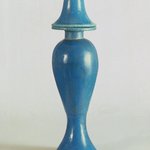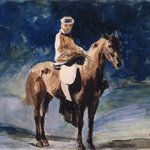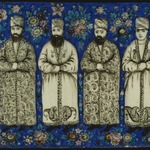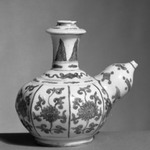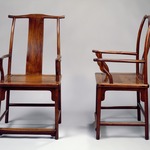

Bottle Depicting a Hunting Scene, first half 17th century. Ceramic; fritware, painted in cobalt blue and black on an opaque white glaze, 11 1/2 × 8 1/4 × 5 1/4 in. (29.2 × 21 × 13.3 cm). Brooklyn Museum, Brooklyn Museum Collection, 34.6024. Creative Commons-BY (Photo: Brooklyn Museum, 34.6024_side1_SL1.jpg)

Bottle Depicting a Hunting Scene, first half 17th century. Ceramic; fritware, painted in cobalt blue and black on an opaque white glaze, 11 1/2 × 8 1/4 × 5 1/4 in. (29.2 × 21 × 13.3 cm). Brooklyn Museum, Brooklyn Museum Collection, 34.6024. Creative Commons-BY (Photo: Brooklyn Museum, 34.6024_side2_SL1.jpg)
Bottle Depicting a Hunting Scene
Arts of the Islamic World
On View: Arts of the Islamic World, 2nd floor
MEDIUM
Ceramic; fritware, painted in cobalt blue and black on an opaque white glaze
GEOGRAPHICAL LOCATIONS
- Place made: Iran
- Possible place made: Mashad, Iran
DATES
first half 17th century
DYNASTY
Safavid
PERIOD
Safavid
DIMENSIONS
11 1/2 × 8 1/4 × 5 1/4 in. (29.2 × 21 × 13.3 cm) (show scale)



COLLECTIONS
Arts of the Islamic World
ACCESSION NUMBER
34.6024
CREDIT LINE
Brooklyn Museum Collection
PROVENANCE
Prior to 1933, provenance not yet documented; before 1933, acquired from an unidentified source by the Brooklyn Museum, acquisition method not documented.
Provenance FAQ
CATALOGUE DESCRIPTION
Flask, flattened body, with a tall neck cut down. The surface of the flask is molded; it is painted under a discolored transparent glaze in cobalt blue with black outlines. The rough base is unglazed. The decoration is reserved on a blue ground and outlined in black. On one side stands a man with an animal round his shoulders; to the left, a woman kneels before him, offering him a cup. The man wears a European costume - a doublet with a ruff and a hat. The woman is more simply dressed in Persian style. Between the figure is a tray of fruit and a glass (?) flask. In the background are flowers and shrubs of different kinds, birds and cloud-scrolls. The other side is decorated with a hunting scene. A man in European costume fires at a hare (?) with his gun; on the right is a wounded crane. From his waist hangs a powder horn in the form of a bird's head and a bag. The background consists of flowers, leaves, and cloud-scrolls.
EXHIBITIONS
MUSEUM LOCATION
This item is on view in Arts of the Islamic World, 2nd floor
CAPTION
Bottle Depicting a Hunting Scene, first half 17th century. Ceramic; fritware, painted in cobalt blue and black on an opaque white glaze, 11 1/2 × 8 1/4 × 5 1/4 in. (29.2 × 21 × 13.3 cm). Brooklyn Museum, Brooklyn Museum Collection, 34.6024. Creative Commons-BY (Photo: Brooklyn Museum, 34.6024_side1_SL1.jpg)
IMAGE
side, side 1, 34.6024_side1_SL1.jpg. Brooklyn Museum photograph
"CUR" at the beginning of an image file name means that the image was created by a curatorial staff member. These study images may be digital point-and-shoot photographs, when we don\'t yet have high-quality studio photography, or they may be scans of older negatives, slides, or photographic prints, providing historical documentation of the object.
RIGHTS STATEMENT
Creative Commons-BY
You may download and use Brooklyn Museum images of this three-dimensional work in accordance with a Creative Commons license. Fair use, as understood under the United States Copyright Act, may also apply.
Please include caption information from this page and credit the Brooklyn Museum. If you need a high resolution file, please fill out our online application form (charges apply).
For further information about copyright, we recommend resources at the United States Library of Congress, Cornell University, Copyright and Cultural Institutions: Guidelines for U.S. Libraries, Archives, and Museums, and Copyright Watch.
For more information about the Museum's rights project, including how rights types are assigned, please see our blog posts on copyright.
If you have any information regarding this work and rights to it, please contact copyright@brooklynmuseum.org.
RECORD COMPLETENESS
Not every record you will find here is complete. More information is available for some works than for others, and some entries have been updated more recently. Records are frequently reviewed and revised, and we welcome any additional information you might have.








